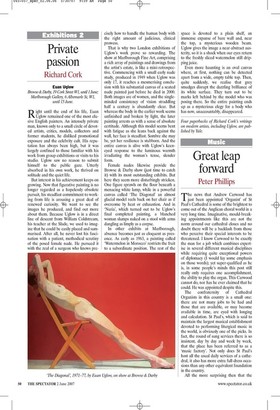Private passion
Richard Cork Euan Uglow Browse & Darby, 19 Cork Street Wl, until 1 June; Marlborough Gallery, 6Albemarle St, Wl, until 15 June.
Right until the end of his life, Euan Uglow remained one of the most elusive English painters. An intensely private man, known only to a small circle of devoted artists, critics, models, collectors and former students, he disliked promotional exposure and the celebrity cult. His reputation has always been high, but it was largely confined to those familiar with his work from group exhibitions or visits to his studio. Uglow saw no reason to submit himself to the public gaze. Utterly absorbed in his own work, he thrived on solitude and the quiet life.
But interest in his achievement keeps on growing. Now that figurative painting is no longer regarded as a hopelessly obsolete pursuit, his steadfast commitment to working from life is arousing a great deal of renewed curiosity. We want to see the images he produced, and find out more about them. Because Uglow is in a direct line of descent from William Coldstream, his teacher at the Slade, we used to imagine that he could be easily placed and summarised. After all, he never lost his fascination with a patient, methodical scrutiny of the posed female nude. He pursued it with the zeal of a surgeon who knows precisely how to handle the human body with the right amount of judicious, clinical prowess.
That is why two London exhibitions of Uglow's work prove so rewarding. The show at Marlborough Fine Art, comprising a rich array of paintings and drawings from the artist's estate, is like a mini-retrospective. Commencing with a small early nude study, produced in 1949 when Uglow was only 17, it reaches a mesmerising conclusion with his substantial canvas of a seated nude painted just before he died in 2000. Both images are of women, and the singleminded consistency of vision straddling half a century is abundantly clear. But whereas the body in the earlier work seems unfinished and broken by light, the later painting arrests us with a sense of absolute certitude. Although this model seems bent with fatigue as she leans back against the wall, her face is steadfast. Sombre she may be, yet her resilience is stubborn. And the entire canvas is alive with Uglow's keeneyed response to the luminous warmth irradiating the woman's tense, slender form.
Female nudes likewise provide the Browse & Darby show (just time to catch it) with its most outstanding exhibits. But here they seem more disturbingly stricken. One figure sprawls on the floor beneath a menacing white lamp, while in a powerful canvas called 'The Diagonal' an almost glacial model reels back on her chair as if overcome by heat or exhaustion. And in `Nuria', which turned out to be Uglow's final completed painting, a blanched woman slumps naked on a stool with arms dangling as limply as a corpse.
In other exhibits at Marlborough, absence becomes just as eloquent as presence. As early as 1963, a painting called 'Watermelon in Morocco' restricts the fruit to a subordinate position. The rest of the space is devoted to a plain shelf, an immense expanse of bare wall and, near the top, a mysterious wooden beam. Uglow gives the image a near-abstract austerity, so it is a shock when our eyes return to the freshly sliced watermelon still dripping juice.
Even more haunting is an oval canvas where, at first, nothing can be detected apart from a wide, empty table top. Then, quite suddenly, we realise that grey smudges disrupt the dazzling brilliance of its white surface. They turn out to be marks left behind by the model who was posing there. So the entire painting ends up as a mysterious elegy for a body who has now, unaccountably, disappeared.
Four paperbacks of Richard Cork's writings on modem artists, including Uglow, are published by Yale.




















































 Previous page
Previous page